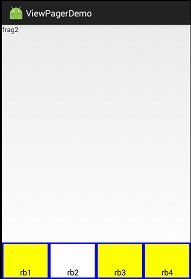ViewPager加RadioGroup构建底部导航
ViewPager 简介
ViewPager可以实现视图的左右滑动效果
ViewPager的继承结构
java.lang.Object
↳android.view.View
↳android.view.ViewGroup
↳android.support.v4.view.ViewPagerViewaPager与ListView类似也需要适配器来承载需要显示的View
An AdapterView is a view whose children are determined by an Adapter.See ListView, GridView, Spinner and Gallery for commonly used subclasses of AdapterView.
ViewPager常用适配器:
| adapter | 含义 |
|---|---|
| PagerAdapter | 填充简单View如图片,可用于实现应用启动欢迎界面 |
| FragmentPagerAdapter | PagerAdapter的子类,可填充Fragment |
| FragmentStatePagerAdapter | PagerAdapter的子类,可以保存Fragment的状态,适合大量的Fragment。可以更好得控制内存。 |
使用FragmentPagerAdapter实现可滑动页面的底部导航栏
在主布局文件(activity_main.xml)中加入ViewPager控件,以及用于底部按钮的RadioGroup
<LinearLayout xmlns:android="http://schemas.android.com/apk/res/android"
android:layout_width="match_parent"
android:layout_height="match_parent"
android:orientation="vertical">
<LinearLayout
android:layout_width="match_parent"
android:layout_height="0dip"
android:layout_weight="6">
<android.support.v4.view.ViewPager
android:id="@+id/viewpager"
android:layout_width="match_parent"
android:layout_height="match_parent" />
LinearLayout>
<LinearLayout
android:layout_width="match_parent"
android:layout_height="0dip"
android:layout_weight="1"
android:background="@color/blue"
android:gravity="bottom">
<RadioGroup
android:id="@+id/rg"
android:layout_width="match_parent"
android:layout_height="match_parent"
android:orientation="horizontal">
<RadioButton
android:id="@+id/rb1"
style="@style/radioBtStyle"
android:background="@drawable/perform"
android:text="rb1" />
<RadioButton
android:id="@+id/rb2"
style="@style/radioBtStyle"
android:background="@drawable/perform"
android:text="rb2" />
<RadioButton
android:id="@+id/rb3"
style="@style/radioBtStyle"
android:background="@drawable/perform"
android:text="rb3" />
<RadioButton
android:id="@+id/rb4"
android:background="@drawable/perform"
style="@style/radioBtStyle"
android:text="rb4" />
RadioGroup>
LinearLayout>
LinearLayout>Radio的样式都一样,因此把它们抽象为一个统一的style
<style name="radioBtStyle">
<item name="android:layout_width">match_parentitem>
<item name="android:layout_height">match_parentitem>
<item name="android:layout_weight">1item>
<item name="android:layout_margin">3dpitem>
<item name="android:gravity">bottom|center_horizontalitem>
<item name="android:button">@null
style>为每个按钮定义selector(perform.xml),在按下时表现不同效果
<selector xmlns:android="http://schemas.android.com/apk/res/android">
<item android:drawable="@color/white" android:state_pressed="true">item>
<item android:drawable="@color/white" android:state_checked="true">item>
<item android:drawable="@color/yellow">item>
selector>FragmentPagerAdapter当然需要首先建立Fragment,本例需要四个Fragment,这里只写出一个Fragment的建立方法
Fragment类
//Fragment1.java
public class Fragment1 extends Fragment {
@Override
public View onCreateView(LayoutInflater inflater, ViewGroup container, Bundle savedInstanceState) {
return inflater.inflate(R.layout.frag1,container,false);
}
}布局文件
<LinearLayout xmlns:android="http://schemas.android.com/apk/res/android"
android:layout_width="match_parent"
android:layout_height="match_parent">
<TextView
android:layout_width="match_parent"
android:layout_height="match_parent"
android:text="frag1"
/>
LinearLayout>在Activity中开始初始化
public class MainActivity extends FragmentActivity {
private List fragmentList;
private ViewPager viewPager;
private RadioGroup radioGroup;
private RadioButton raBt1, raBt2, raBt3, raBt4;
private int[] rbResId = new int[]{R.id.rb1, R.id.rb2, R.id.rb3, R.id.rb4};
@Override
protected void onCreate(Bundle savedInstanceState) {
super.onCreate(savedInstanceState);
setContentView(R.layout.activity_main);
initViews();
//具体视图数据的装载容器
fragmentList = new ArrayList();
fragmentList.add(new Fragment1());
fragmentList.add(new Fragment2());
fragmentList.add(new Fragment3());
fragmentList.add(new Fragment4());
/**
*相当于ListView的各种适配器(BaseAdapter,ArrayAdapter,SimpleAdapter)
* FragmentAdapter,ViewPager的适配器,为ViewPager返回Fragment
*/
FragmentManager fm = getSupportFragmentManager();
viewPager.setAdapter(new FragmentPagerAdapter(fm) {
@Override
public Fragment getItem(int position) {
return fragmentList.get(position);
}
@Override
public int getCount() {
return fragmentList.size();
}
});
/**
* RadioGroup监听器,底部按钮按下时回掉此方法
*/
radioGroup.setOnCheckedChangeListener(new RadioGroup.OnCheckedChangeListener() {
@Override
public void onCheckedChanged(RadioGroup group, int checkedId) {
for (int i = 0; i < rbResId.length; i++) {
//按下按钮时设置对应的Fragment
if (rbResId[i] == checkedId) {
viewPager.setCurrentItem(i);
}
}
}
});
/**
*ViewPager页面监听器,当页面改变时会回调监听器
*/
viewPager.setOnPageChangeListener(new ViewPager.OnPageChangeListener() {
@Override
public void onPageScrolled(int position, float positionOffset, int positionOffsetPixels) {}
@Override
public void onPageScrollStateChanged(int state){}
@Override
public void onPageSelected(int position) {
//滑动到当前页面时,设置对应的按钮为选中状态
radioGroup.check(rbResId[position]);
}
});
/**
* 当然初始化为第一个RadioButton与第一个Fragment
*/
radioGroup.check(R.id.rb1);
} 分析一下使用步骤:
1. 创建一个容器存储所有的视图数据Fragment
2. 创建一个FragmentPagerAdapter,它的构造函数必须要传入一个FragmentManager。ps:如果要自定义自己的adapter,就要同时传入存储数据的容器和FragmentManager
3. 通过ViewPager的setAdapter()绑定适配器
4. 创建并绑定RadioGroup的按钮选中监听器以及ViewPager的页面选中监听器
5. 因为fragment页面和button的选中状态是相辅相成的,在按钮选中监听器中会调用viewPager.setCurrentItem()来同步页面状态,在页面选择监听器用radioGroup.check()来同步按钮状态。


